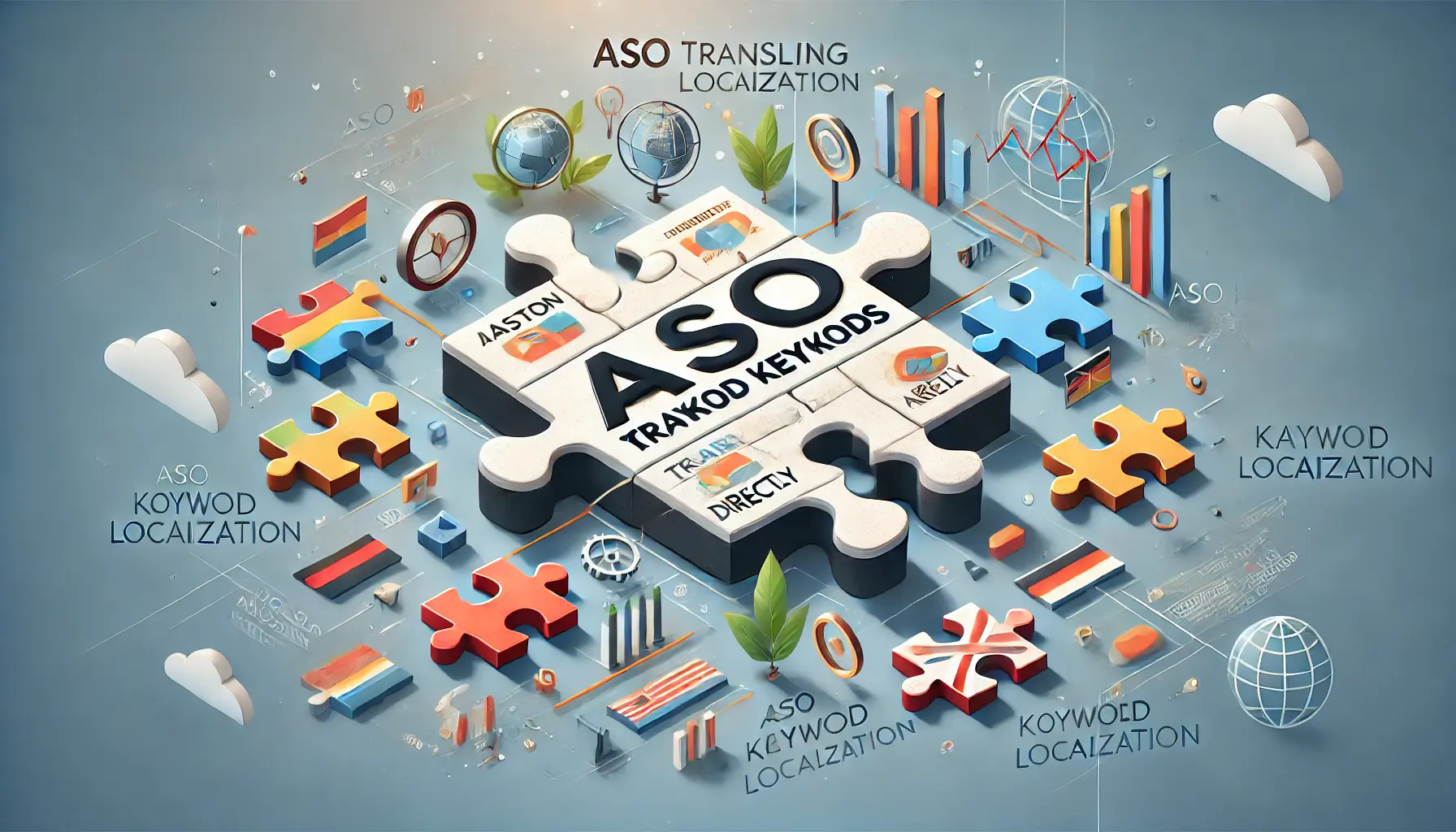With millions of apps available in the market, having a brilliant product is not enough to attract users in today’s competitive mobile landscape.
This requires a specific strategy when it comes to App Store Optimization (ASO), especially with an international audience.
This is where ASO Keyword Localization comes in.
This highly increases the visibility of your app and provides more users from different regions by customizing keywords based on languages and cultures.
So what does ASO Keyword Localization actually mean, and why is it so important to the success of your app?
This post will concentrate on the strategies, tools, and methodologies for you to uncover keyword localization so that your app can successfully enter international markets.
These apps need to be localized for the keywords they use, which is why ASO keyword localization is essential in app store optimization.
ASO Keyword Localization is an essential part of an ASO strategy, especially if you are targeting users in more than one country.
In a nutshell, this is the practice of optimizing your app keywords for the language(s), culture, and regional search behaviors.
But it involves more than just updating the text, and as I will show you, this is not merely a translation issue.
It’s about understanding how users in different markets discover apps like yours so that at least some keywords should be optimized for them.
Yes, that is true, but what is Keyword Localization?
Localization involves researching and integrating the best and most effective keywords in other languages possible into your app metadataInformation that provides details about other data, such as app descriptions, titles, and keywords..
Your app name, subtitle, keyword field, and even the app description need to be optimized for these local markets.
This aims to make your app surface in search results when people from other countries look for apps but use their language.
Localized content—can be in the form of screenshots, descriptions, and even titles—as one factor that heavily impacts ASO.
The App Store features millions of apps people love — but how do they find the ones that match their interests?
Localizing your ASO keywords boosts the discoverability of your app in a wide range of regions, increasing downloads and overall effectiveness.
- Two Types of Keyword Strategies: Global and Local
- Myths of Keyword Localization
- Factors Weighing in ASO Keyword Localization Success
- How It Works: Tools & Techniques of a Successful Keyword Localization
- Roadblocks in Going Local with App Store Keywords
- Success Stories: Case Studies of ASO Keyword Localization
- Conclusion: Final Thoughts on ASO Keyword Localization
- ASO Keyword Localization: Frequently Asked Questions
Two Types of Keyword Strategies: Global and Local
The pros and cons of going global vs.
local with your ASO Keyword Localization.
A global strategy leverages the same group of keywords in all markets, while a local one optimizes search through unique themes particular to each market.
That said, both approaches have their benefits and challenges.

Image representing a global approach to keyword strategy in ASO, emphasizing consistency and coherence across regions.
Global Keyword Strategy
A global keyword strategy ensures your app remains consistent with its branding and messaging in all markets.
This can especially serve as an advantage if both the name and concept of the app are self-explanatory enough that no alteration is needed.
However, that strategy could reduce the discoverability of your app in markets where consumers search differently or have differing cultural norms.

Image representing a localized approach to keyword strategy in ASO, highlighting adaptation to different regional markets.
Local Keyword Strategy
Conversely, a local keyword strategy lets you customize your keywords to the needs and habits of consumers in each market.
This can greatly improve the app’s reach and relevance in those areas.
But it also means the task of researching and optimizing keywords for each market separately increases.
Choosing between global and local keyword strategies is crucial for optimizing your app’s visibility in international markets. Each approach has its benefits and challenges that should be carefully considered.

Image symbolizing the breaking of myths and misconceptions in ASO Keyword Localization, emphasizing clarity and correct understanding.
Myths of Keyword Localization
How to do ASO Keyword Localization – A Few Myths and Facts.
The common assumption is that keywords can be directly translated, which leads to dire consequences.
But in reality, direct translations miss the nuances behind how users across markets search for apps.
For starters, you need to do keyword research for each target language to understand how users actually search.
One other myth is that localization is only needed for non-English markets.
While the usage of English is common, there are various local regions where they prefer to search for apps in their native language.
You could also be losing a massive part of your potential user base by disregarding these markets.
Another misconception is that keyword localization is a task to be done once.
You can search engine optimize it like anything, but in reality, that is an ongoing process.
Localized keywords: With changes in user search behaviors and market trends, localizing your app keywords will help you keep up with those new terms.
This will help your app stay relevant and visible in all markets, but it also means the keyword updates have to be done more often.
Direct translation of keywords is not enough for effective localization. Understanding cultural nuances and regional search behaviors is essential to avoid common pitfalls.

Image symbolizing the importance of balancing multiple factors like culture, market trends, and regional specifics in ASO Keyword Localization.
Factors Weighing in ASO Keyword Localization Success
Meaning, ASO keyword localization should not only involve translating them into different languages but also understanding what drives people to search for apps and their preferences across the regions.
Well, to the extent that you make localization before internationalization, these factors directly affect how well your keyword expansion and localization will be.
Here are some of the most important factors that will substantially determine your ASO Keyword Localization success:

Image symbolizing the importance of understanding and adapting to cultural differences and language redistributions in ASO Keyword Localization.
Cultural Differences and Language Redistributions
When localizing keywords for ASO, it is critical to understand the cultural intricacies and language differences within each target market.
Translating keywords may not be sufficient; you want to understand how those words are used in cultural context.
For instance, expressions or words that are popular in a particular region can mean something completely different or be hardly recognizable in another place.
- Local Slang and Colloquialisms: These refer to the regional slang or colloquial language used in describing services. They can be far more effective than standard translations in keyword localization.
- Formal or Informal Language: This will also help you know which type of language your target audience uses and adjust your keywords accordingly.
- Regional Dialects: There are usually some dialects that differ from country to country and may even be completely different in one region of a single country. Tailoring your keywords to these regional differences can give your app even more relevance.

Image representing the dynamic nature of keyword trends and their activity across different global markets in ASO Keyword Localization.
Market (Keyword) Activity Trends
The trends in market-specific keywords can differ greatly from one region to another.
What works in one country may not work in another, so it is important that you stay current with respect to keyword trends within each target market.
- Local Search Queries: Study the top search queries in your target location to find out what users are regularly looking for. This can guide your ASO keyword localization.
- Trending Topics: Look for trends in the region that may affect how users are searching. By implementing these trends in your keyword strategy, you can increase the visibility of your app.
- Competitor Analysis: Understand which keywords your competitors are targeting and how well they perform in all the markets. This analysis can provide tips and tricks that help you succeed in ASO keyword localization.

Image representing the concept of analyzing and adapting to different search patterns across various global regions in ASO Keyword Localization.
Search Patterns by Region
It is important to know how users search for apps in different global regions before you start ASO localization of keywords.
This behavior might change greatly due to language, cultural customs, and local technology trends.
- Long Tail vs. Short Tail: Users in different areas may use longer, more descriptive queries or short and to-the-point ones. Crafting your keywords to align with these preferences will aid in getting more visibility for your apps.
- Search Intent: Think about what people are really searching for in the specific market. Are users looking to find specific features, solve a problem, or for entertainment? Matching your keywords with user intent is one of the best practices in ASO keyword localization.
- Device/Platform Preferences: Different regions may have different preferences for devices and platforms. Knowing this can help you target the right audience with your optimized keywords.

Image symbolizing the importance of complying with local laws and app store policies for successful ASO Keyword Localization.
Comply with Local Laws and App Store Policies
In addition, some of your ASO keyword localization strategy also depends on local regulations and app store guidelines.
Each area can have various sets of regulations regarding content, privacy, and advertising that should be considered when optimizing your keywords.
- Content Restrictions: Understand the content restrictions in your targeted market that might change the keywords you are allowed to use. For instance, some words or phrases may be prohibited, and others might need special approval.
- Advertising Guidelines: Make sure to follow the local advertising guidelines to avoid penalties or rejection from the app store due to the keywords used.
- Privacy Laws: Different regions have different privacy laws, which you must consider when collecting data for ASO. Ensure your keyword strategy is in line with these guidelines.
By considering these key factors, you will be able to effectively localize app store keywords that appeal to users in every key region, ultimately optimizing your app’s visibility and success.
Cultural differences, market trends, and regional search patterns are key factors that determine the success of your ASO keyword localization efforts.

Image representing the process and mechanics of using tools and techniques for successful ASO Keyword Localization.
How It Works: Tools & Techniques of a Successful Keyword Localization
Achieving the best ASO Keyword Localization possible means understanding a particular culture to align with market tendencies and accurately carry out your plan.
If you use the appropriate resources, localization will be easier to execute flawlessly and will maximize your efforts to show up on all desirable keywords across multiple international markets.

Image representing the process of conducting precise and strategic keyword research using ASO tools in the context of global markets.
Keyword Research with ASO Tools
The initial step towards powerful keyword localization is conducting deep research with the help of ASO tools.
This will allow you to select the most relevant keywords for each market, based on their search trends as well as user and competitor behavior.
Here are a few essential tools to keep in mind:
- App Annie: A comprehensive tool that gives you visibility over your keyword rankings and search trends, as well as access to competitor analysis by region. This is very important for finding the best-performing keywords in your niche markets.
- Sensor Tower: A tool that helps collect data on how certain keywords are performing, what apps rank highest for specific phrases, and includes user reviews. Through Sensor Tower, you can find which keywords are most likely to work for your app and in what parts of the world.
- Mobile Action: A great ASO tool that not only gives you suggestions about keywords but also helps you keep track of rankings and competitors. This is especially good for finding long-tail keywords often missed in more general searches.
- Google Keyword Planner: While primarily used for SEO, Google Keyword Planner works well for understanding how search volume and competition of keywords differ in other languages and countries, aiding in keyword localization.

Image representing the automated and streamlined nature of the localization process in ASO Keyword Localization, highlighting efficiency and global application.
Automate Localization Steps
Time-Saver: App localization can be done quickly and with fewer errors through automation.
Many tools and platforms exist with automation capabilities to ease the process of translating and localizing your keywords and other app metadata.
These kinds of tools will allow you to scale your keyword localization efforts without sacrificing consistency:
- Transifex: A localization platform that allows for translation process automation. It integrates with many apps and services, making the management and update of published content easier.
- Phrase: A powerful API tool that automates the entire localization operation. It supports a number of file formats and enables real-time collaboration on localization projects between translators working for your team.
- Smartling: A state-of-the-art cloud-based platform that automates translation and localization processes. Smartling provides real-time translation updates, helping ensure your localized content remains current.

Image symbolizing the importance of collaboration with native language suppliers to achieve effective ASO Keyword Localization.
Working with Native Language Suppliers
Although tools and automation can greatly support your keyword localization strategy, working with native speakers is fundamental to ensure the result is culturally accurate and relevant.
These experts can provide insights into regional language use, cultural nuances, and behavior—information that cannot be fully captured by automated tools alone.
- Local Translators: Working with local translators who understand the cultural context can ensure that your keywords are not only accurately translated but also resonate with the target audience.
- Localization Agencies: Partnering with agencies that specialize in ASO can help you access a pool of linguistic resources. These agencies often take care of everything from keyword research to final implementation.
- In-House Language Teams: If you have the resources, creating an in-house language team focused on localization can ensure greater control over your ASO keyword localization strategy, aligning it closely with your overall marketing goals.

Image representing the continuous process of testing and optimizing localized keywords in ASO Keyword Localization.
Testing and Optimizing Localized Keywords
After you have localized your keywords, the next step is to continuously test and optimize them to ensure they continue delivering results.
Ongoing testing will help you identify which keywords are bringing in traffic and conversions, or which need to be adjusted.
- A/B Testing: Run A/B tests on different sets of localized keywords to see which perform better. This will allow you to perfect your keyword strategy over time.
- Track Performance: Compare the performance of your localized keywords in each market using ASO tools. Track and measure the impact with metrics like search rankings, download rates, and user engagement.
- Feedback Loops: Set up feedback loops with regional users to understand what works and does not work in the app stores across regions. This feedback can provide valuable insights for further optimization.
Overall, with the right automation tools and professional expertise, followed by constant improvement of your methods, localizing keywords for apps will continue to ensure global market success!
Utilizing the right tools and techniques can streamline your keyword localization process, ensuring that your app resonates with users across different regions.

Image representing the challenges and obstacles encountered in the localization process of app store keywords.
Roadblocks in Going Local with App Store Keywords
Even though ASO Keyword Localization has many advantages, there are challenges to it.
It is important to identify these hurdles and find ways to tackle them so that your localization efforts add value as intended and help blaze the trail for global market growth for your app.

Image representing the risks and common mistakes encountered in the process of translating keywords directly in ASO Keyword Localization.
Pitfalls of Translating Keywords
The biggest trap in ASO Keyword Localization is basic translation of keywords, often known as dictionary translation.
Although this may sound like a simple strategy, it often results in poor localization.
- Context Matters: The way words are used or what they mean in another language may not translate effectively to the target market, thus losing their meaning. It is vital to ensure that your localized keywords align with the cultural and linguistic context of the target audience.
- Synonyms and Regional Variations: Different parts of the world use different words for the same concept. Investigating and learning about these variations will allow you to better select the ideal keywords for each market.
- Avoiding Literal Translations: Literal translations often generate phrases that are either clunky or nonsensical, neither of which will resonate with users. Instead, aim to capture the spirit and message of the original keywords.

Image representing the challenge of balancing global consistency with local relevance in ASO Keyword Localization.
Striking the Balance Between Global Consistency and Local Relevance
Balancing a global brand with the right key differences between different locations is crucial.
We strive to maintain a healthy balance between making the app recognizable and attractive for users in all countries.
- Global and Local Keywords: Decide which keywords you will keep consistent across all markets and which ones should be localized. For example, you may keep the brand name of your app consistent globally, but have different descriptive keywords by region.
- Maintain Brand Identity: Make sure your app does not lose its core brand identity while localizing the keywords. This includes ensuring that the message, tone, and values all remain consistent across every market.
- Balance Testing: Test your localized keywords on a regular basis to find the sweet spot between global consistency and local specificity. A/B testing is especially useful for this purpose.

Image representing the complexity and importance of managing various localized versions of an app or content in ASO Keyword Localization.
Managing Multiple Localized Versions
As your app grows and is rolled out locally into more regions, managing the various localized versions can become complex.
Organizing and coordinating different keyword sets, app store listings, or content updates requires careful planning.
- Centralized Management: Use a single platform or tool to centralize all your localized content. This allows you to track progress, enforce consistency, and simplify the localization workflow.
- Update Often: Make sure to update your localized keywords and app store listings frequently as market trends, user behavior, and competition change regularly. Staying current is key to maintaining relevance.
- Work Together: Collaborate with your localization teams, marketing departments, and other stakeholders to ensure that everything aligns and optimizes the effectiveness of your global messaging.

Image representing the ongoing process of frequently reviewing and refreshing keywords in ASO Keyword Localization.
Frequent Reviewing and Refreshing of Keywords
It is important to remember that ASO Keyword Localization is an ongoing process and requires regular maintenance to be successful.
Market conditions can change, user behavior varies, and competitor strategies evolve over time.
You want to ensure that you are proactively optimizing your localized keywords as needed.
- Performance of the Targeted Keywords: Regularly analyze how well your keywords are ranking locally with ASO tools. Monitor search results, install rates, and user engagement to uncover weaknesses.
- Adjusting to Market Trends: New trends emerge, others fade, and you need keywords that reflect what users are currently searching for. This might involve refreshing your keywords for modern trends, new technologies, or changes in user habits.
- Optimize Continuously: Your localized keywords need to be optimized regularly so that they always stay effective. This means constantly checking which keywords are working for you and updating them as search terms or market conditions change.
By understanding and addressing these challenges, you will develop a stronger ASO Keyword Localization strategy that can elevate your app to the next level in global markets.
Translating keywords without considering cultural context can lead to poor localization results. It’s essential to balance global consistency with local relevance.

Image representing the success and achievements in keyword localization as highlighted in various case studies.
Success Stories: Case Studies of ASO Keyword Localization
Let’s look at some real-world examples of how effective ASO Keyword Localization can impact your app.
The purpose of these case studies is to show you how apps have localized their keywords and benefited from better rankings, more visibility in app stores, and consequently higher downloads.

Image representing the strategy and achievement in reaching the European audience through effective ASO Keyword Localization.
Case Study 1: How to Reach Out in the European Market
A mobile gaming app initially set out to target new user acquisition in the European market, specifically English-speaking countries.
Through their ASO strategy, including app keyword localization, the app was able to ensure that its use was discovered by relevant users in Germany, France, and Spain.
This resulted in increased app visibility and a 30% rise in downloads within the first three months of implementation.
- Language Experts: The app team analyzed keyword performance in each target language, supplementing this with a human touch to build an effective working model. This involved a deep understanding of cultural nuances and regional slang within the keyword strategy.
- Market Preference Adaptation: The app’s marketing materials, including screenshots and descriptions, were all localized to reflect the preferences of each target market, further enhancing the app’s appeal.
- Results: The app saw a 30% increase in downloads and a 25% rise in user engagement in the localized regions.

Image representing the strategy and achievement in reaching the Asian audience through effective ASO Keyword Localization.
Case Study 2: Tackling the Asian Mobile App Market
An educational app aimed at teaching English targeted the Asian market, specifically Japan, South Korea, and China.
The app developers understood the importance of keyword localization in these regions.
- Cultural Sensitivity: The team conducted in-depth research into local search trends and cultural preferences. They discovered that users in these regions favored specific learning methods and educational terminology.
- Keyword Adaptation: The app’s keywords were carefully localized to reflect these preferences. In Japan, the team used keywords related to structured learning and exam preparation, while in China, they focused on keywords that emphasized rapid language acquisition.
- Results: The app experienced a 40% increase in downloads within six months, with a noticeable improvement in user retention and satisfaction in the Asian markets.

Image representing the concept of using effective techniques and best practices for successful localization in ASO Keyword Localization.
Best Practices in Localization Techniques
These case studies prove that ASO Keyword Localization is not simply about translating words from one language to another.
It requires a deep understanding of local cultures, search behaviors, and market trends.
- Research: Effective localization starts with thorough research. Understanding what your audience says and how they think is crucial for selecting the right keywords.
- Ongoing Optimization: Localization is not static. Constantly renewing and adjusting keywords based on performance data and market changes is essential for ongoing success.
- Collaboration with Locals: It is essential to work with native language experts and local marketers, as they can provide deep insights that automated tools might miss. Effective localization always involves collaboration.

Image representing the key takeaways and important points from the process of ASO Keyword Localization.
ASO Keyword Localization Takeaways
In conclusion, ASO Keyword Localization is a critical factor in your app’s success in global markets.
Understanding the challenges, using appropriate tools, and learning from successful case studies can help you create a localization strategy that resonates with a large user base.
- Targeted Keywords: Deploy region-specific and product-specific keywords that are relevant to your target market. The rule of thumb is to focus on the most relevant keywords for downloads.
- Stay Agile: Accept that your localization strategy will need to evolve as market realities shift. Flexibility and responsiveness are key to long-term success.
- Invest in Expertise: Employing local knowledge through native language experts or specialized agencies can help ensure your localization efforts are effective.
By following these principles, your app can thrive in competitive markets and achieve lasting success through effective ASO Keyword Localization.
Real-world examples of successful keyword localization highlight the importance of cultural understanding and continuous optimization in achieving global success.

Image symbolizing the final thoughts and concluding insights on ASO Keyword Localization.
Conclusion: Final Thoughts on ASO Keyword Localization
In this multi-part series, we have covered the steps to ensure your app is correctly translated and localized for foreign markets as part of an ASO strategy.
Now it’s time to finish with some closing conclusions.
ASO Keyword Localization should not be a mere tactical implementation in your app store optimization strategy, but rather an essential element that could make or break your app’s success in global markets.
This process allows you to tailor your keywords to be relevant to users from other regions, cultures, or languages, which in turn increases visibility (ranking higher), downloads, and user engagement.

Image representing the importance of recognizing and adapting to cultural differences in ASO Keyword Localization.
Why It Is Important to Understand Cultural Nuances
Cultural understanding is one of the main takeaways from this article on ASO Keyword Localization.
Translating keywords from one language to another is not all it takes.
You need to delve deeper into your target market’s cultural preferences.
This approach helps you choose words that are not just linguistically accurate but also carry cultural significance, making your app more appealing to users.

Image representing the synergy between using the right tools and expert insights for effective ASO Keyword Localization.
Tools and Expert Collaboration
This article emphasized the significance of using ASO tools and collaborating with local experts to enhance your keyword localization efforts.
Tools like App AnnieA tool used for tracking app store analytics, including keyword rankings and trends. or Sensor TowerAn analytics platform that provides insights into mobile app performance and market trends. allow you to dive deeper into overall keyword research and performance analysis.
However, the human component—native language experts—ensures you still get keywords that resonate with the audience in their local context.

Image representing the continuous nature of optimization and the importance of flexibility in ASO Keyword Localization strategies.
Optimization and Flexibility, Always
ASO Keyword Localization is an ongoing process that should be dynamically adjusted.
Markets evolve, user behaviors change, and new trends arise.
Businesses must maintain an agile localization strategy to handle these changes effectively.
Updating your keywords and reassessing demographic data based on performance insights and competitor activity helps sustain visibility and long-term success.

Image representing the structured approach required to achieve success in ASO Keyword Localization.
Know the Essential Steps of ASO Keyword Localization for Success
To summarize, here are the essential steps for successful ASO Keyword Localization:
- Conduct thorough research on the cultural and linguistic variations of your target markets.
- Monitor the performance of top keywords over time using ASO tools.
- Work with language experts who are native to a region and culture for accurate and relevant keyword translation.
- Continuously improve your keywords with data insights and market trends.
- Strike the perfect balance between global consistency and local relevance to keep your brand strong while adapting to what works best in different regions.
With these steps, you can create a robust ASO Keyword Localization strategy that expands your global reach and ensures sustained app success in the long run.

Image representing the impact and effectiveness of ASO keyword localization as a powerful tool for mobile app success.
ASO Keyword Localization: A Powerful Tool
This guide to ASO Keyword Localization is designed to help you make a difference in these competitive markets.
Effective localization will allow you to connect better with users, understand their specific needs, and enable your app to scale new heights.
An investment in time and resources for good localization is a game changer for your app’s success—especially as global communication platforms like WhatsApp and Facebook Messenger continue to grow.
Remember that ASO is a long-term endeavor; localization—like your keyword strategy or icon design—is something you need to continuously refine.
Keep yourself updated, make ongoing improvements, and focus on delivering value to users around the world.
ASO Keyword Localization can be a linchpin in your app’s success story if done right.
ASO Keyword Localization is a dynamic process that requires ongoing effort. Understanding cultural nuances, using appropriate tools, and collaborating with experts are key to long-term success.

Image representing the idea of addressing frequently asked questions about ASO keyword localization.
Boost your mobile app's success with our guaranteed App Store Optimization (ASO) service. Leave it to the experts!
ASO Keyword Localization: Frequently Asked Questions
Here we share some of the essential questions related to ASO Keyword Localization, addressing your most common concerns and challenges in these areas.
ASO Keyword Localization means adapting the app keywords to different languages and contexts so users from specific regions can find your app easily.
This process improves rankings and increases downloads worldwide.
Understanding cultural importance ensures that the keywords in your app are not only translated correctly but also localized.
Without proper cultural adaptation, it’s unlikely users outside your region will download and engage with your app.
Optimizing keywords requires meticulous research using ASO tools, market trend insights, and local search behaviors for each target geography.
Collaborating with native language experts helps maintain the cultural context in your keywords.
Essential tools for ASO Keyword Localization include App Annie and Sensor Tower for keyword research and performance tracking, Google Keyword Planner for discovering target keywords, and other tools for cross-market competitor analysis.
Localized keywords should be reviewed and updated regularly based on performance data and market trends.
Regular updates ensure that your keywords continue to provide good visibility in target markets.
Yes, ASO Keyword Localization acts as a powerful catalyst for improving your app rankings on app stores, making your app more discoverable by targeted users, thereby increasing downloads and overall performance.
Working with native language experts ensures that your keywords are authentically translated and adapted to the way a target audience speaks, making your app more relatable and effective in localization efforts.
ASO Keyword Localization is an ongoing strategy that needs to be revisited and optimized periodically due to changing market trends, user behavior, and new practices to keep your app visible in search results.
Common pitfalls include relying on direct translations, missing cultural specifics, and neglecting ongoing updates.
Poor localization practices can harm your app’s visibility in new markets, leading to decreased success.











